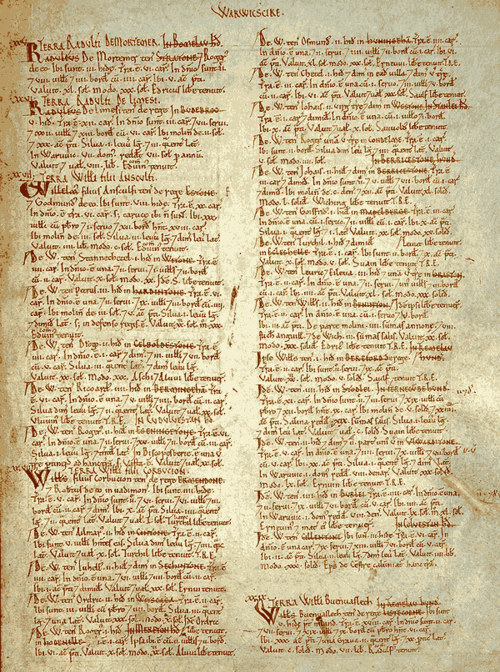
What is the Domesday book? The Domesday Book is the old English spelling of “Doomsday Book” and it was a survey by William the Conqueror of the financial state of England and Wales in 1086.
The book wasn’t called the Domesday book until the following century. It was so named because it was a final judgement on the state of the land and was not open to question, similar to the last judgement at doomsday. You could not appeal what was written in the book. Domesday book had more of an air of reverence about it. “Dome” meant a judgement or law and not the fatalistic meaning it has today. The book had no name originally, but it came to be called the “Liber de Wintonia”, which means “Book of Winchester”. That might seem like a strange name for it, but the book was kept in Winchester because it was the capital of England through the Middle Ages and during the beginning of the Norman period. This didn’t last because London was a far larger city and trade center. William the Conqueror and his son gradually moved the trappings of the government to London, which because the capital of England in the 12th century.
William I became king of England in 1066 when he defeated King Harold. He had been the Duke of Normandy and he had a distant connection to the childless king Edward the Confessor. William was Edward’s first cousin once removed. William’s grandfather was the brother of Emma of Normandy, who was Edward’s mother. A little convoluted, but it was enough for William the Conqueror to lay claim to the throne and invade England. He arrived in 1066 and famously defeated King Harold at Hastings. Harold had just won a battle against the Danes and force marched his troops 320 km to Hastings when he heard William had landed. Had he taken more time and arrived with less exhausted troops, who knows what would have happened. Anyway, he lost, and William of Normandy became King William I. His position was unstable and he spent a lot of his reign putting down rebellions. As a way to take control and raise more taxes, he commissioned the Domesday Book.
William had conquered England, which was a feudal country. That meant all land was owned by the king and leased out. The king could gift land to his lords, but they only held it for him, and it had to be returned when asked. They paid for the privilege of holding the land. These lords could then break up their land and sublet it to other nobles, who would break it up and sublet it, all the way down to the peasant farmers who would sublet a tiny piece of land. The peasants would give a large percentage of what they produced as payment for the land and all of the money would slowly go upwards until it got to the king. When William took control of England, a lot of the existing nobles had been killed. The order of society had been messed up, and a lot of his nobles from Normandy had moved in and he had given them land as a reward for their help. After a few years had passed, those nobles were starting to question the amount of land they had received and also to question William’s authority. A lot of the nobles hid what they had and refused to pay taxes. William needed to accomplish three things: he needed to work out what land there was and who was holding it, he needed to show the nobles that his government was stable and he was the ultimate power, and he needed to see where all the money was so he could tax it. The Domesday Book did this.
William sent out his officials to every county in England and Wales. His officials spoke Latin and French, while the majority of the common people spoke Medieval English, so translators were necessary as well. The officials recorded everything. They recorded the people that owned the land, the number of animals on the land, and the number of buildings, such as mills. They recorded the number of people that lived on the land, listing the heads of households. They noted how much the land was worth. Then they brought their lists back and a scribe wrote them up. It appears to have been written by one scribe and then checked by another who made some corrections. It contains over two million words and is written in a form of abbreviated Latin that is extremely hard to read.
The Domesday Book was an impressive achievement and it is a fascinating historical document. It was kept in a chest for hundreds of years before it was stored in a climate controlled facility. However, as a list of everything in the country, it would have been out of date just as soon as it was finished. Most likely, though, William was just showing his power and the fact that he could have a list like this made. It would have persuaded the nobles to pay their tax. And this is what I learned today.
Try these next:
Sources
https://www.bbc.co.uk/bitesize/articles/zkpm7yc
https://en.wikipedia.org/wiki/Domesday_Book
https://en.wikipedia.org/wiki/William_the_Conqueror
https://www.nationalarchives.gov.uk/education/resources/domesday-book
https://www.houseofnames.com/blogs/DomesdayBook
https://www.worldhistory.org/image/9476/great-domesday-book
https://www.travelwessex.com/Domesday-Book.html
https://www.bbc.co.uk/history/british/normans/doomsday_01.shtml
https://www.csmonitor.com/1986/0423/zdome.html
https://www.royal.uk/william-the-conqueror
Image By Unknown author – Birmingham 1066-1625, Public Domain, https://commons.wikimedia.org/w/index.php?curid=7685223
